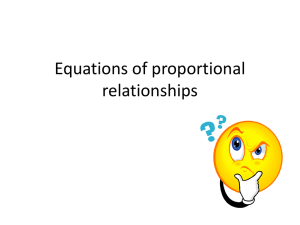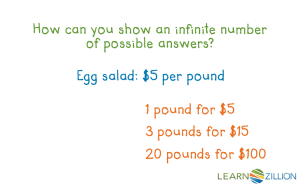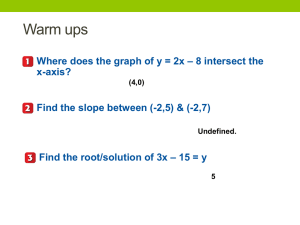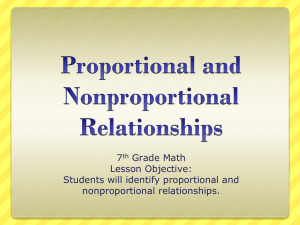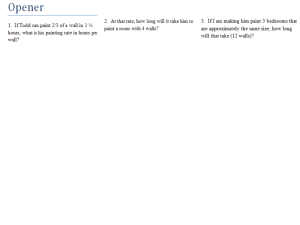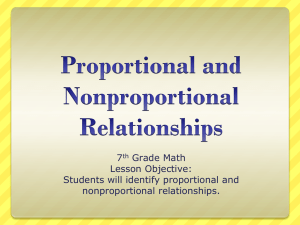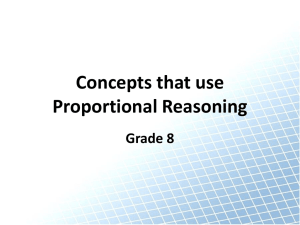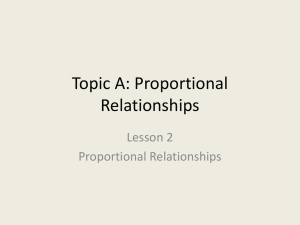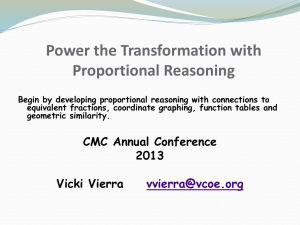Topic A: Proportional Relationships
advertisement
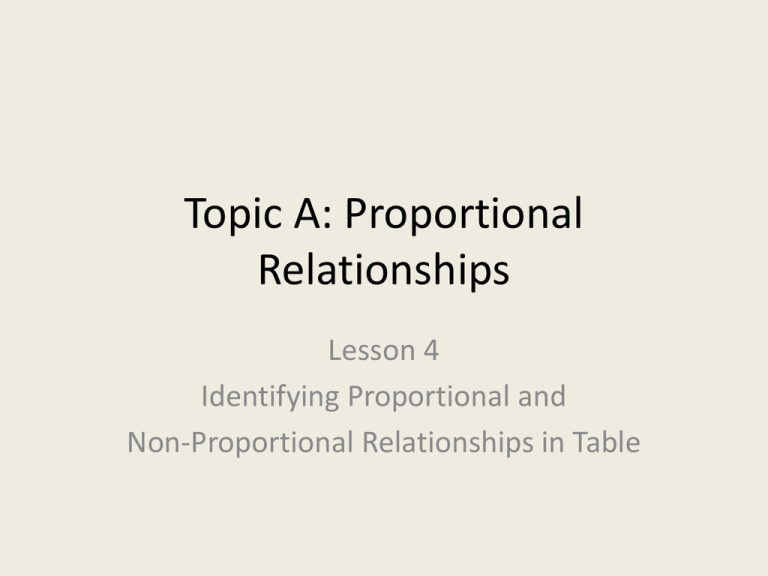
Topic A: Proportional Relationships Lesson 4 Identifying Proportional and Non-Proportional Relationships in Table Topic A Overview Lesson 1: An Experience in Relationships as Measuring Rate Lesson 2: Proportional Relationships Lessons 3-4: Identifying Proportional and NonProportional Relationships in Tables Lessons 5-6: Identifying Proportional and NonProportional Relationships in Graphs LEARNING TARGET Lesson 4: Identifying Proportional & Non-Proportional Relationships in Tables Today I can determine if data in a table represents a proportional or non-proportional relationship by determining if there’s a constant of proportionality for each set of x and y values. STANDARDS 7.RP.2a Decide whether two quantities are in a proportional relationship, e.g., by testing for equivalent ratios in a table or graphing on a coordinate plane and observing whether the graph is a straight line through the origin. KEY VOCABULARY Proportional Constant Constant of Proportionality AGENDA – Day 1 • (5 min) Review Key Vocabulary • (10 min) Warm-Up: Which Team Will Win the Race? • (10 min) Share Solutions • (10 min) MODEL: Finding the Constant of Proportionality • (10 min) Proportional or NonProportional? • (10 min) Extension • (5 min) Exit Ticket • (30 min) Online Practice Review Key Vocabulary • Proportional – when two quantities simplify to the same ratio. • Constant – a quantity having a value that does not change or vary. • Constant of Proportionality - a constant value of the ratio of two proportional quantities. Warm-Up: Which Team Will Win the Race? You have decided to run in a long distance race. There are two teams that you can join. Team A runs at a constant rate of 2.5 miles per hour. Team B runs 4 miles the first hour and then 2 miles per hour after that. Task: Create a table for each team showing the distances that would be run for times of 1-6 hours. Team A Time (hrs) Team B Distance (miles) Time (hrs) 1 1 2 2 3 3 4 4 5 5 6 6 Distance (miles) MODEL: Finding the Constant of Proportionality Team A runs at a constant rate of 2.5 miles per hour. Team A Time (hrs) 1 2 3 4 5 6 Distance (miles) MODEL: Finding the Constant of Proportionality Team B runs 4 miles the first hour and then 2 miles per hour after that. Team B Time (hrs) 1 2 3 4 5 6 Distance (miles) Proportional or Non-Proportional? 1. For which team is distance proportional to time? Explain your reasoning. 2. Explain how you know the distance for the other team is not proportional to time? Extension 1. If the race were 2.5 miles long, which team would win? Explain. 2. If the race were 3.5 miles long, which team would win? Explain. 3. If the race were 4.5 miles long, which team would win? Explain. Exit Ticket The table below shows the relationship between the side lengths of a regular octagon and its perimeter. Side Length, s Perimeter, P 1. Complete the table. 2. If Gabby wants to make an octagon with a side length of 20 inches using wire, how much wire does she need? Justify your reasoning with an explanation of whether perimeter is proportional to the side length. (inches) 1 2 (inches) 8 16 3 4 9 24 32 12 LEARNING TARGET Lesson 3: Identifying Proportional & Non-Proportional Relationships in Tables Today I can determine if data in a table represents a proportional or non-proportional relationship by determining if there’s a constant of proportionality for each set of x and y values. STANDARDS 7.RP.2a Decide whether two quantities are in a proportional relationship, e.g., by testing for equivalent ratios in a table or graphing on a coordinate plane and observing whether the graph is a straight line through the origin. KEY VOCABULARY Proportional Constant Constant of Proportionality AGENDA – Day 2 • (10 min) Warm-Up • (5 min) Review Key Vocabulary • (5 min) Review: Which Team Will Win the Race? • (20 min) Discussion • (25 min) Lesson 4 Problem Set • (30 min) Lesson 4 Quiz Warm-Up: Day 2 Does the table show that y is proportional to x? Explain. X 1 2 3 4 Y 4 8 12 16 Review Key Vocabulary • Proportional – when two quantities simplify to the same ratio. • Constant – a quantity having a value that does not change or vary. • Constant of Proportionality - a constant value of the ratio of two proportional quantities. Review: Which Team Will Win the Race? You have decided to run in a long distance race. There are two teams that you can join. Team A runs at a constant rate of 2.5 miles per hour. Team B runs 4 miles the first hour and then 2 miles per hour after that. Task: Create a table for each team showing the distances that would be run for times of 1-6 hours. Team A Time (hrs) Team B Distance (miles) Time (hrs) 1 1 2 2 3 3 4 4 5 5 6 6 Distance (miles) Discussion 1. For what length race would it be better to be on Team B than Team A? Explain. 2. Using the relationship, if the members on the team ran for 10 hours, how far would each member run on each team? 3. Will there always be a winning team, no matter what length of the course? Why or why not? Discussion Continued… 4. If the race were 12 miles long, which team should you choose to be on if you wish to win? Why would you choose this team? 5. How much sooner would you finish on that team compared to the other team? Lesson 4 – Problem Set 1 Point (Unsatisfactory) 2 Points (Partially Proficient) 3 Points (Proficient) A correct answer Missing or incorrect Missing or incorrect with some evidence answer and little answer but of reasoning or an evidence of evidence of some incorrect answer reasoning reasoning with substantial evidence 4 Points (Advanced) A correct answer supported by substantial evidence of solid reasoning Lesson 4 – Quiz 1 Point 2 Points (Unsatisfactory) (Partially Proficient) 3 Points (Proficient) A correct answer Missing or incorrect Missing or incorrect with some evidence answer and little answer but of reasoning or an evidence of evidence of some incorrect answer reasoning reasoning with substantial evidence 4 Points (Advanced) A correct answer supported by substantial evidence of solid reasoning
